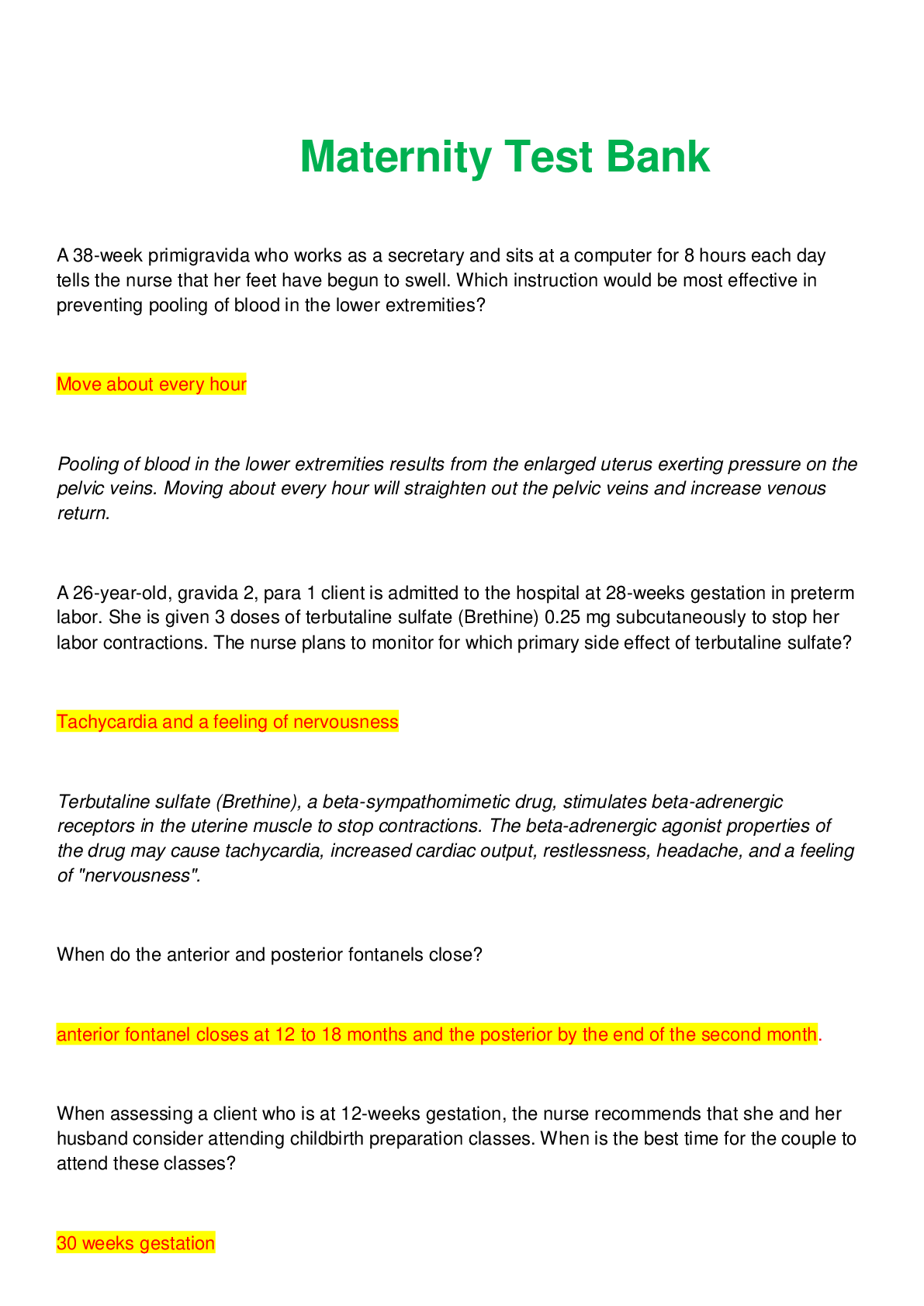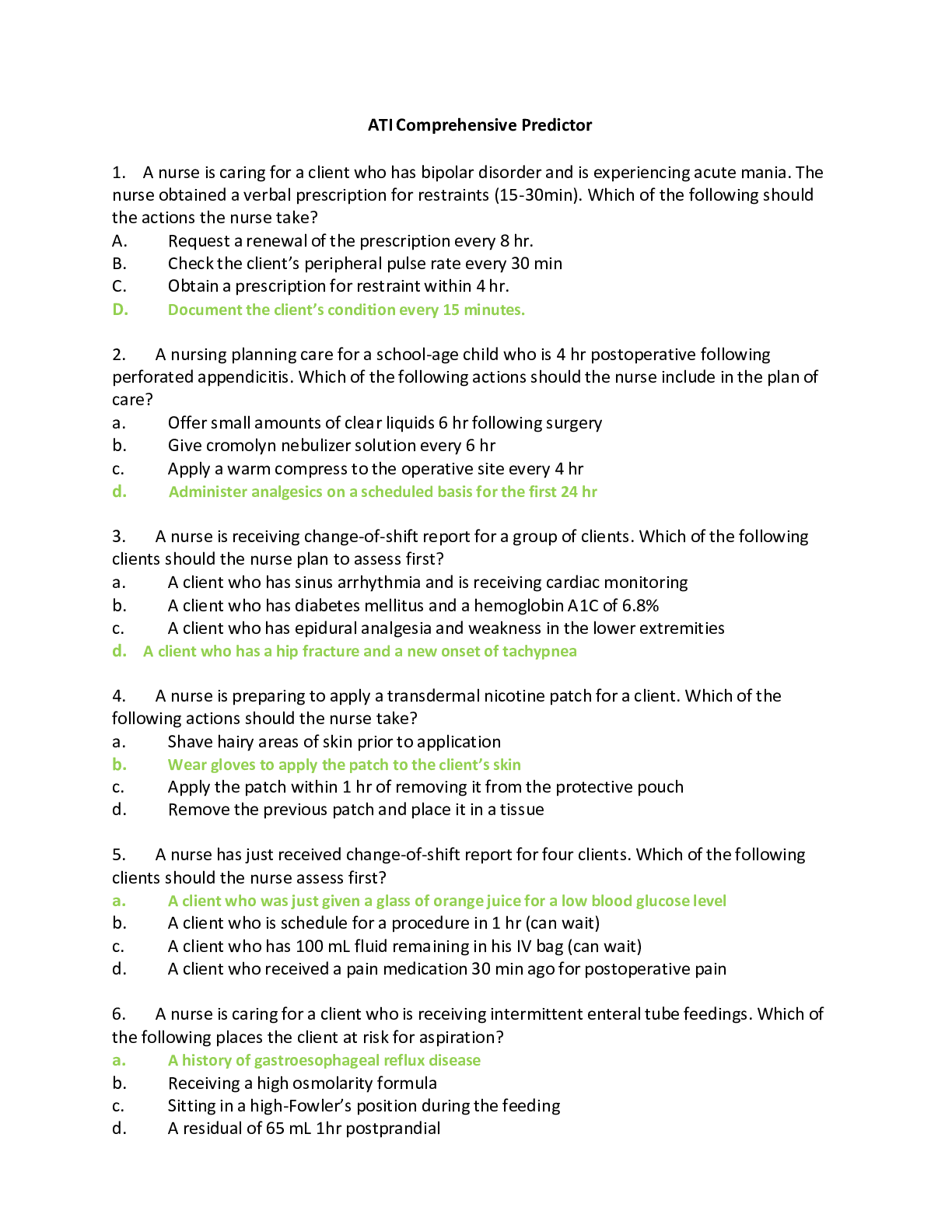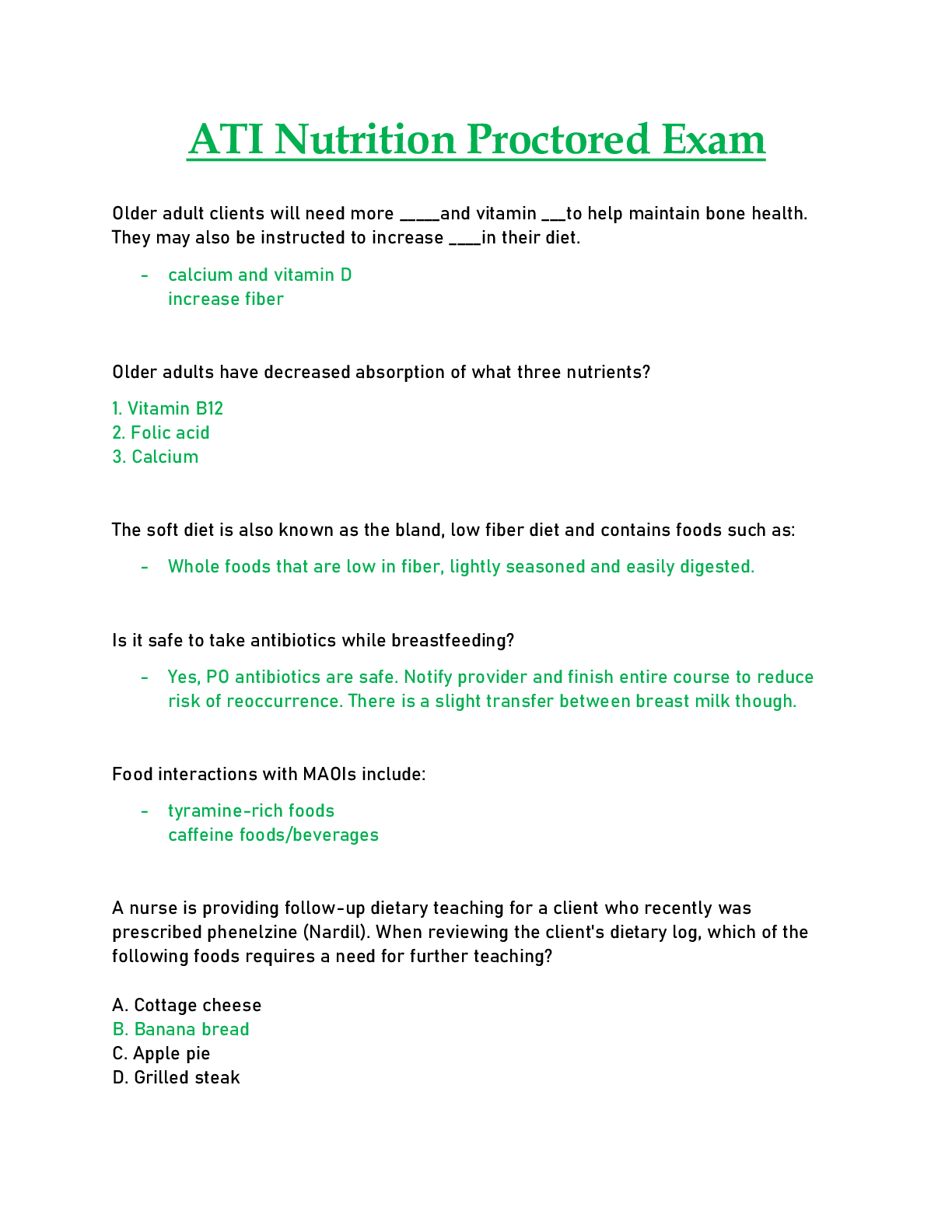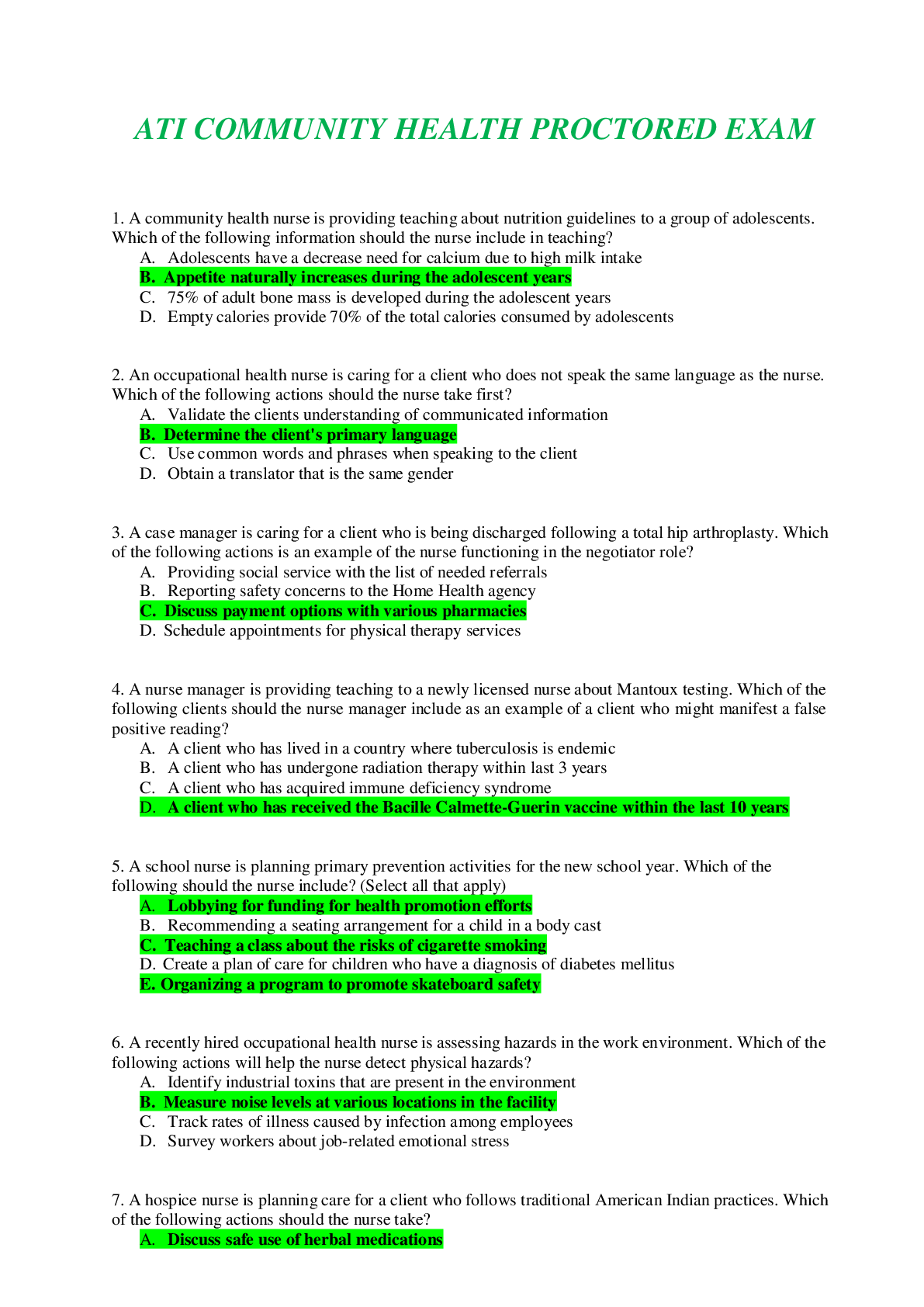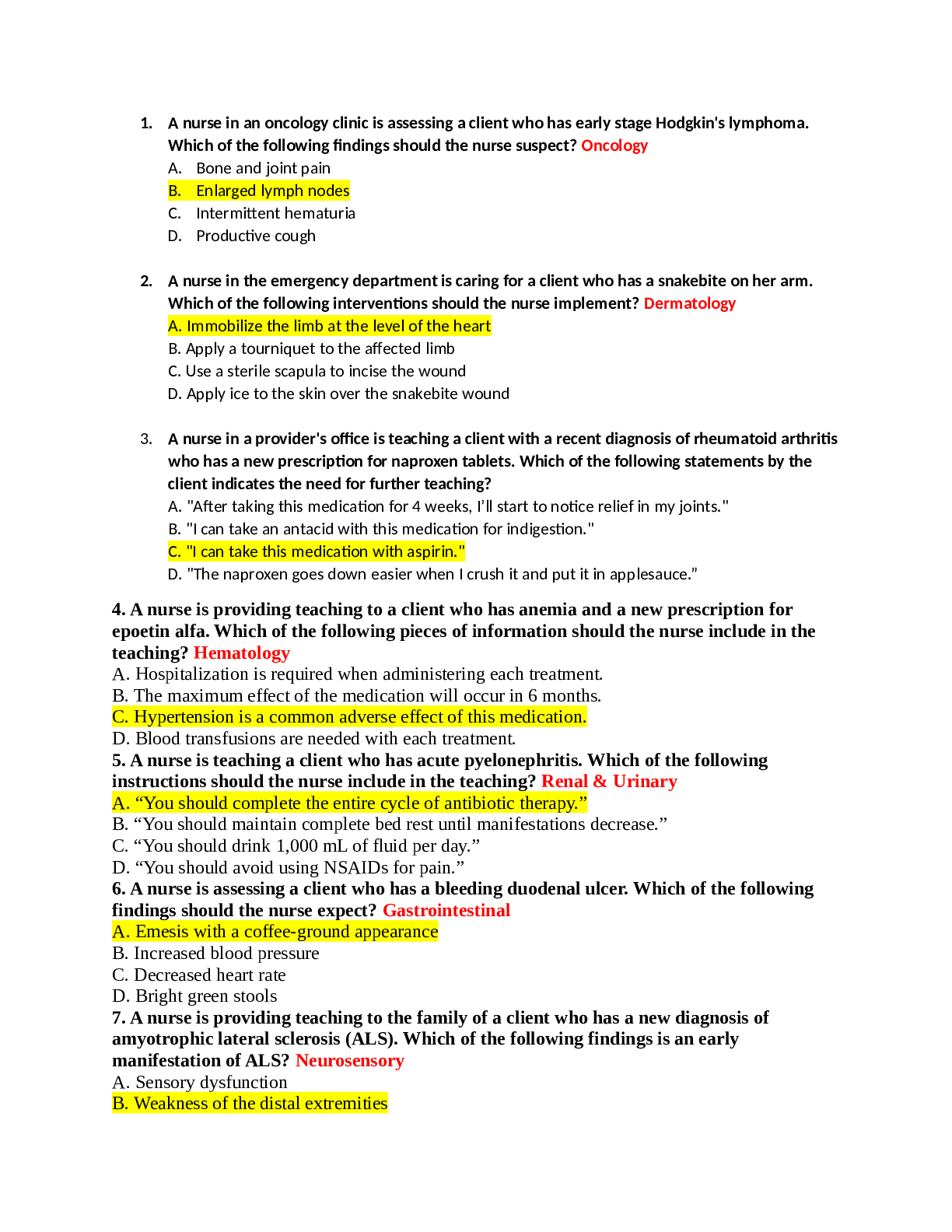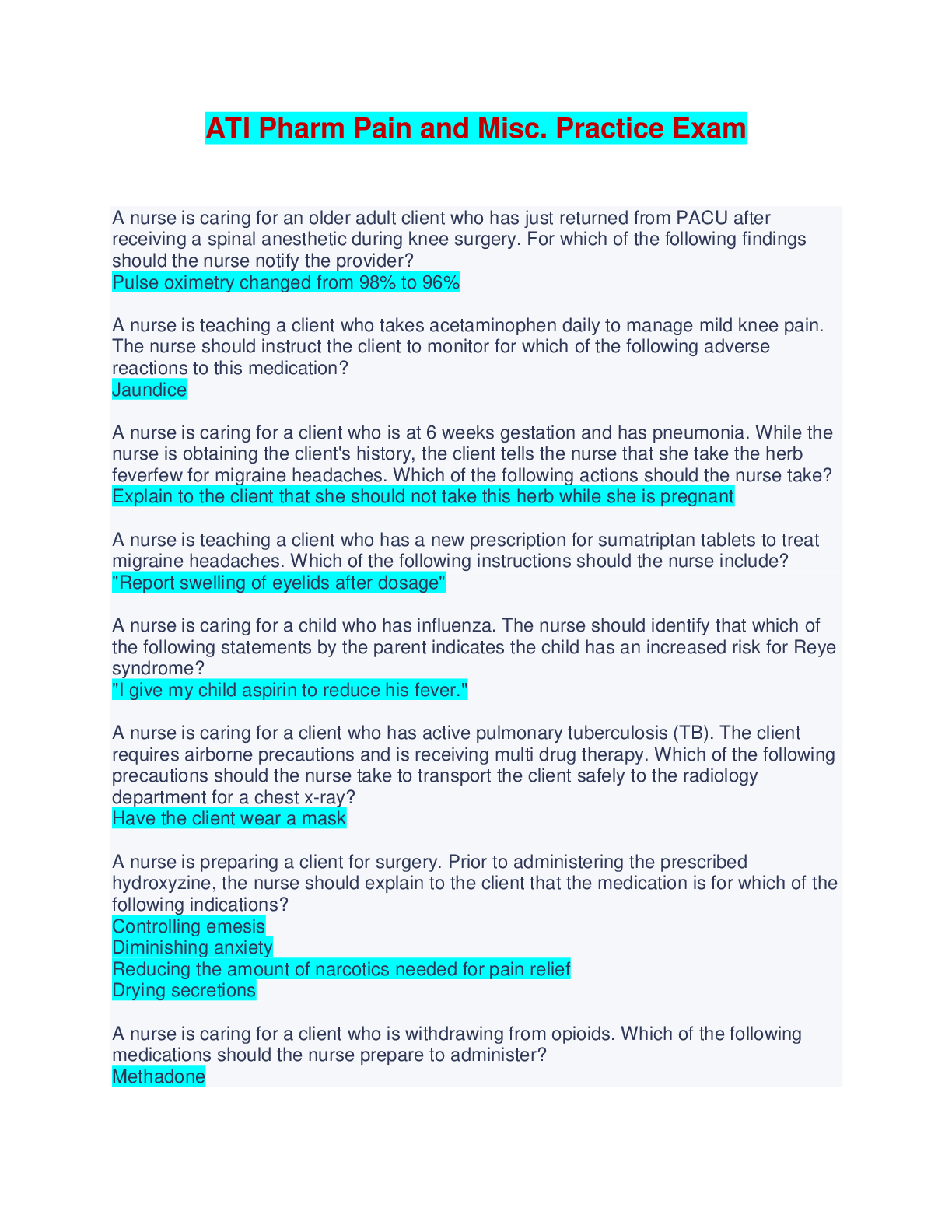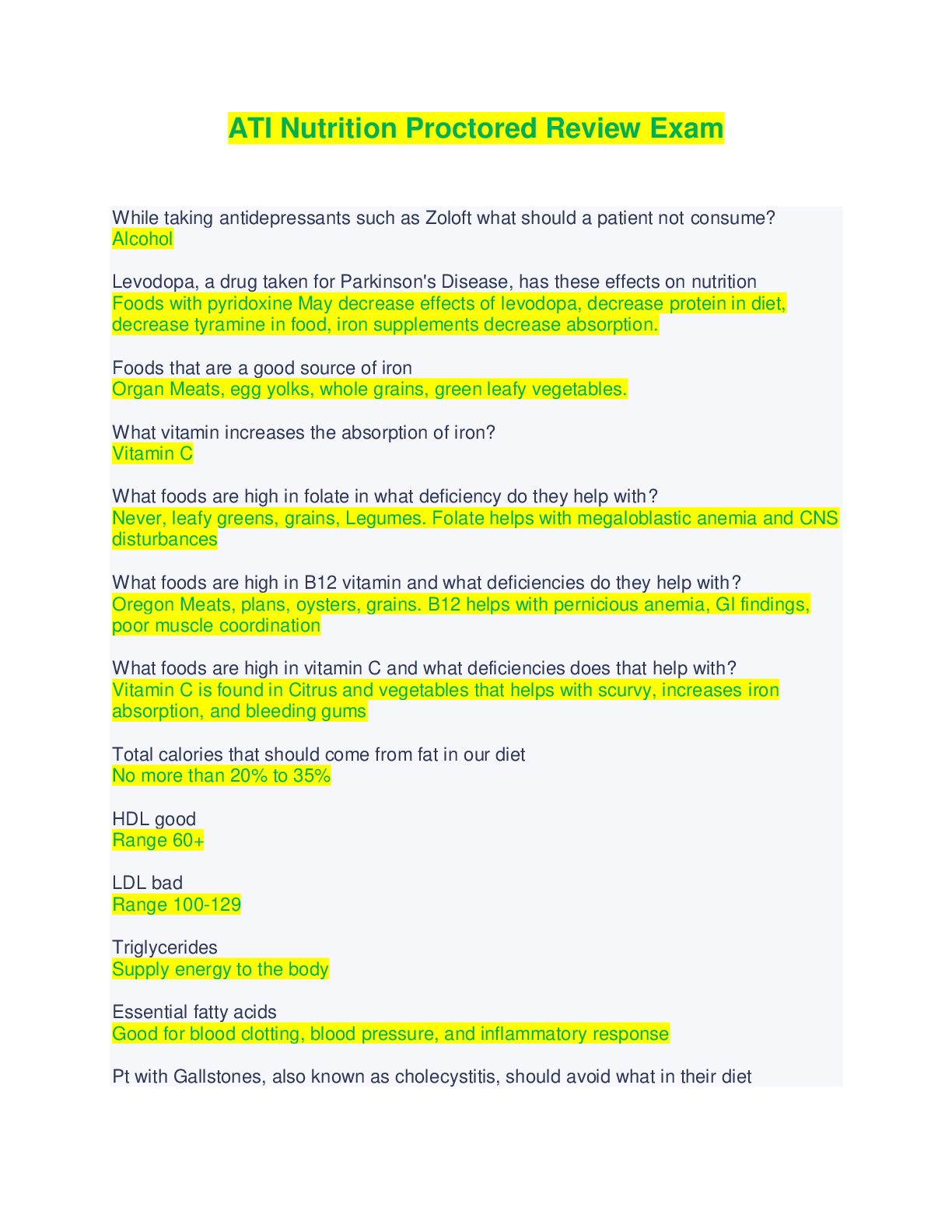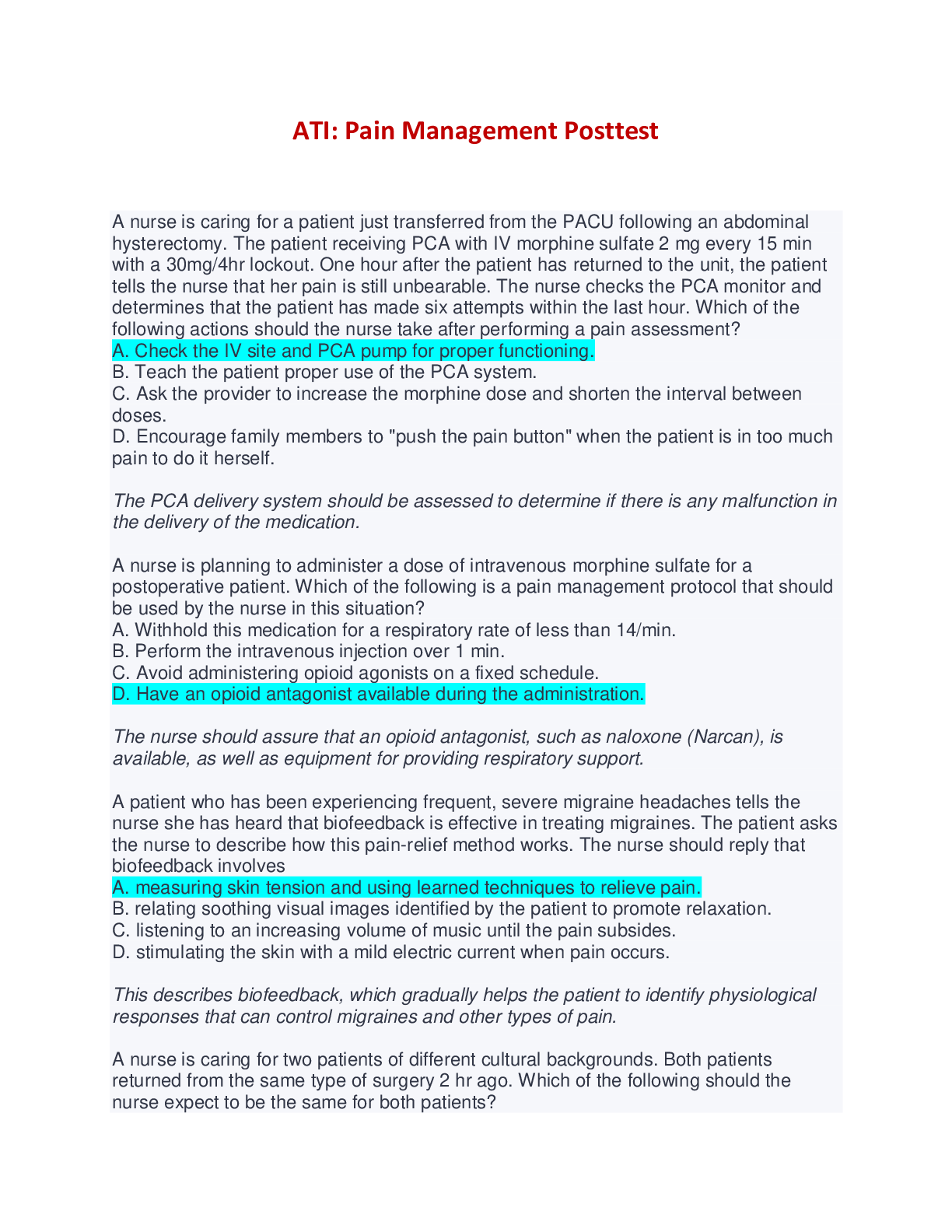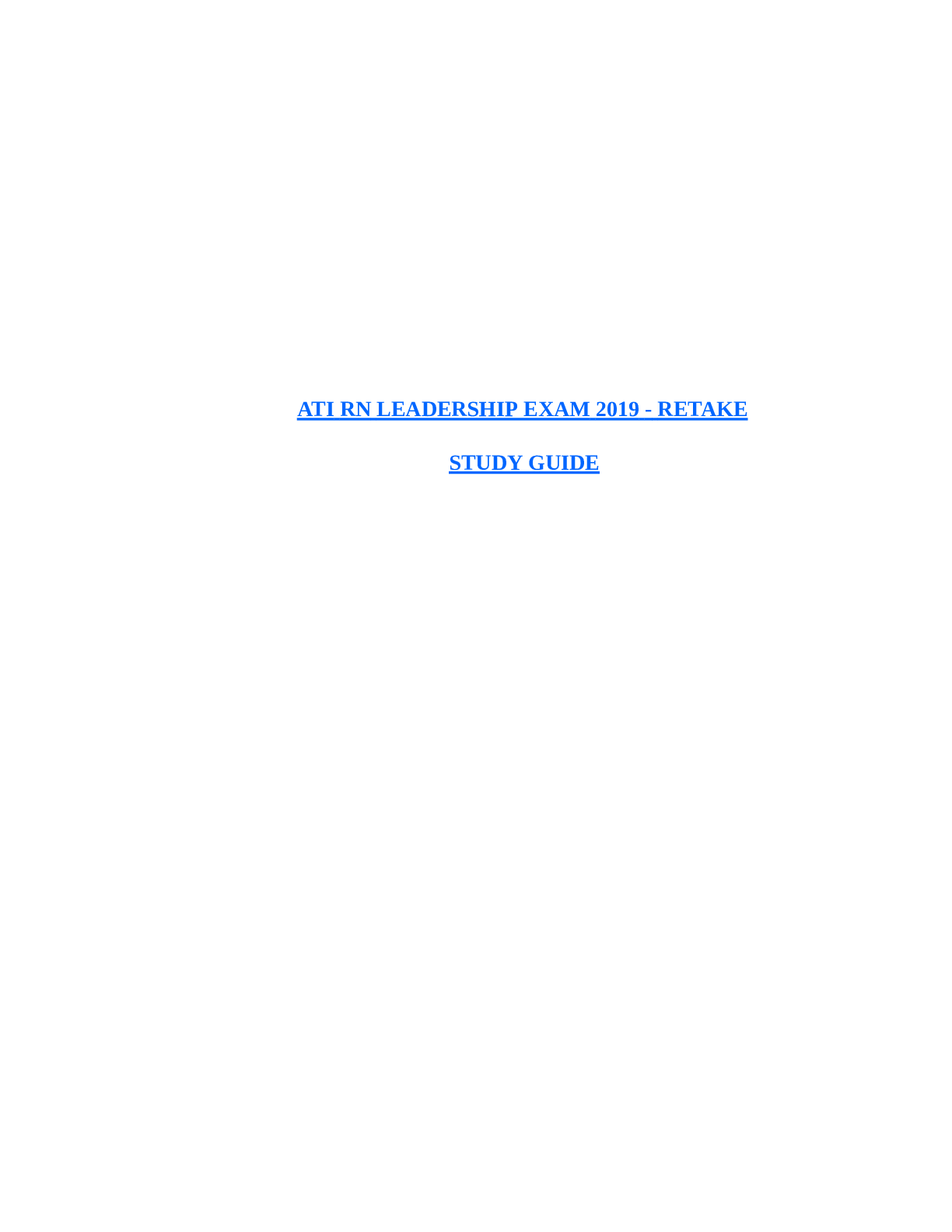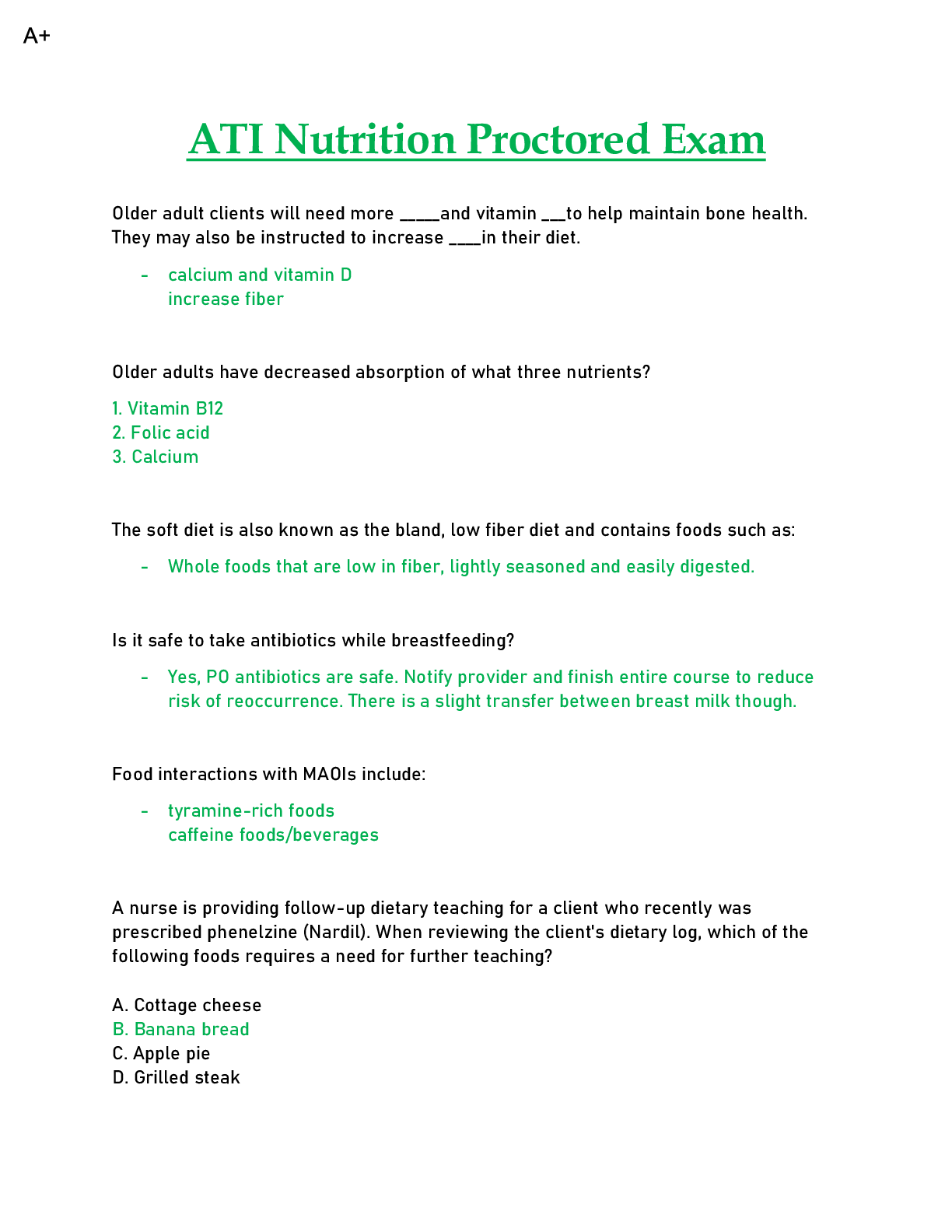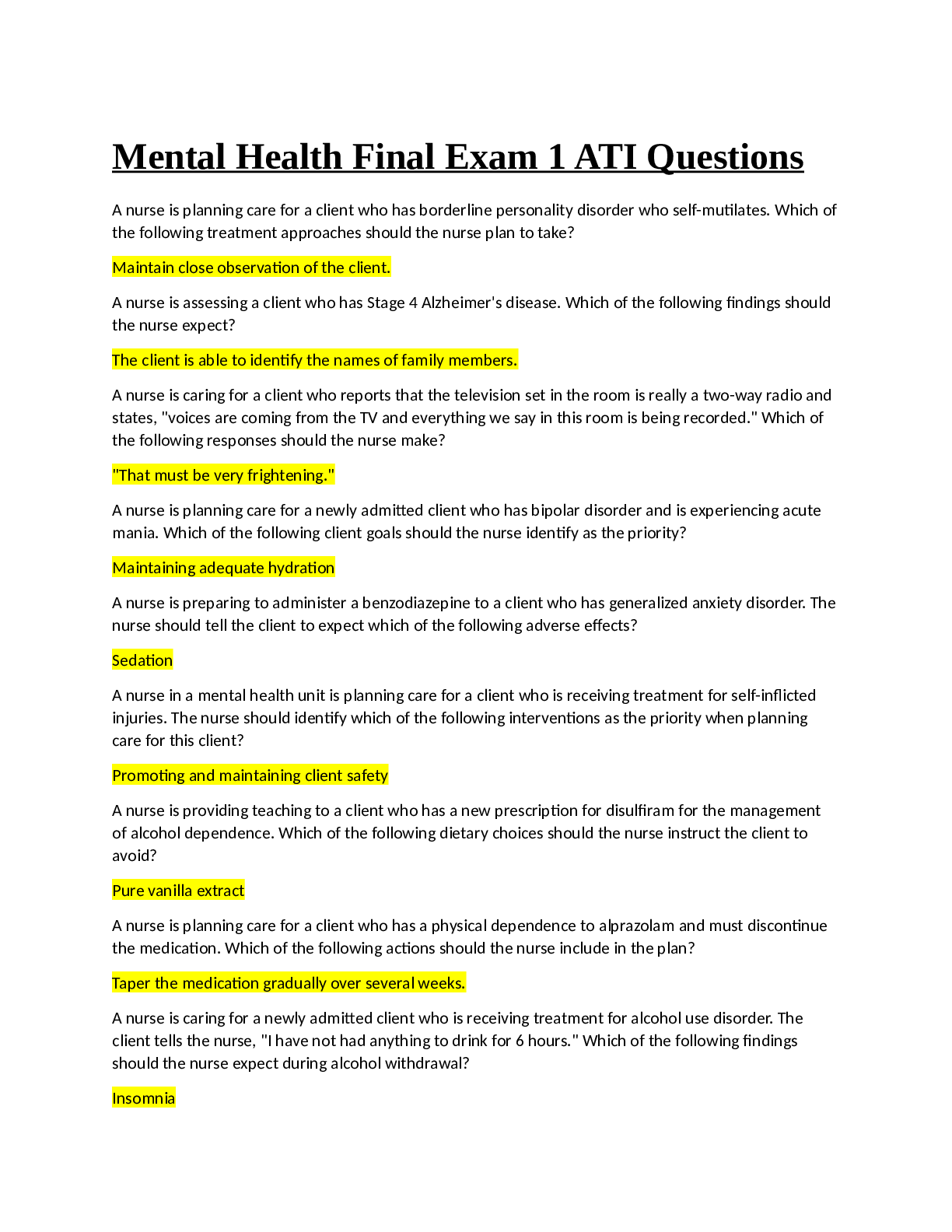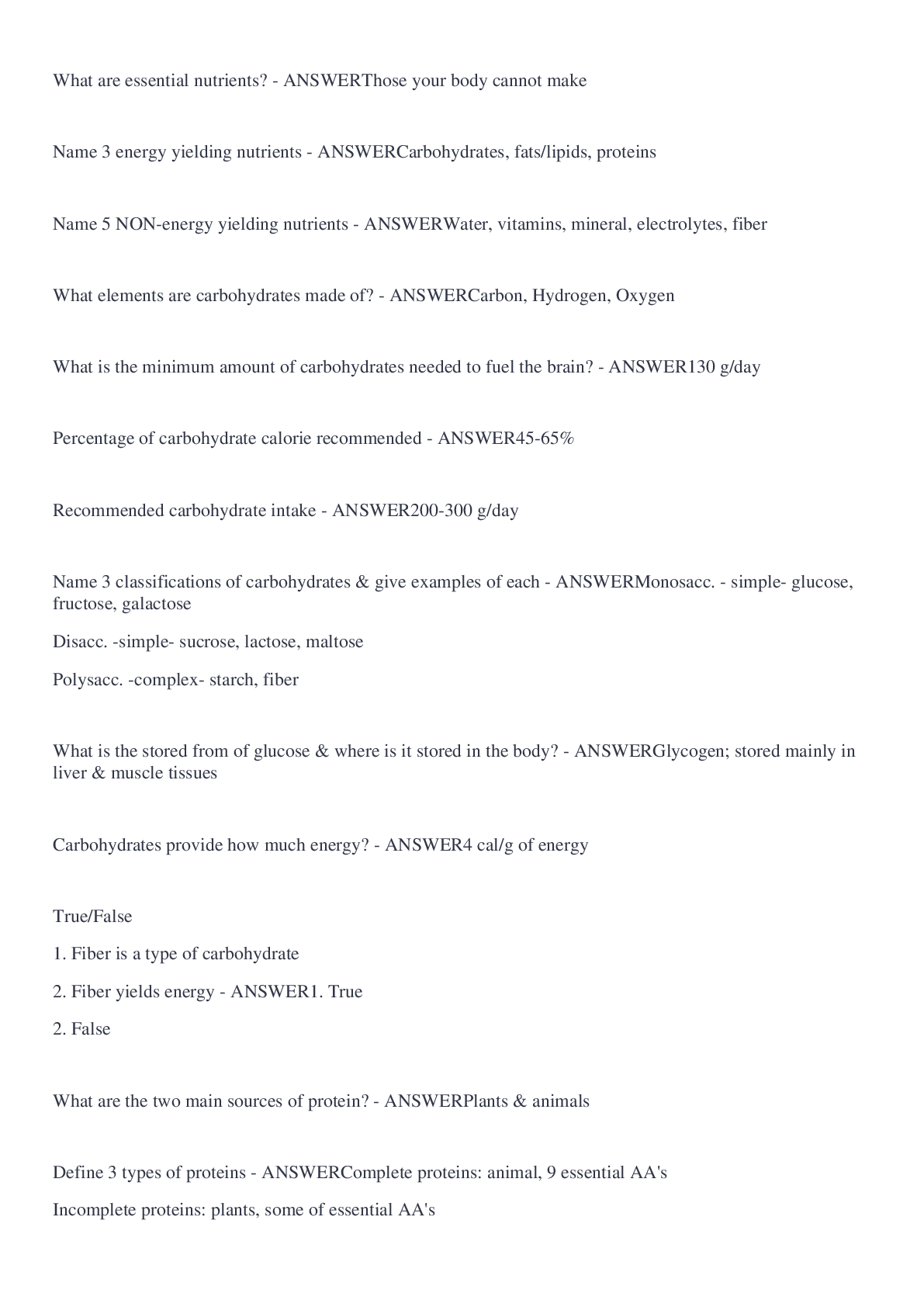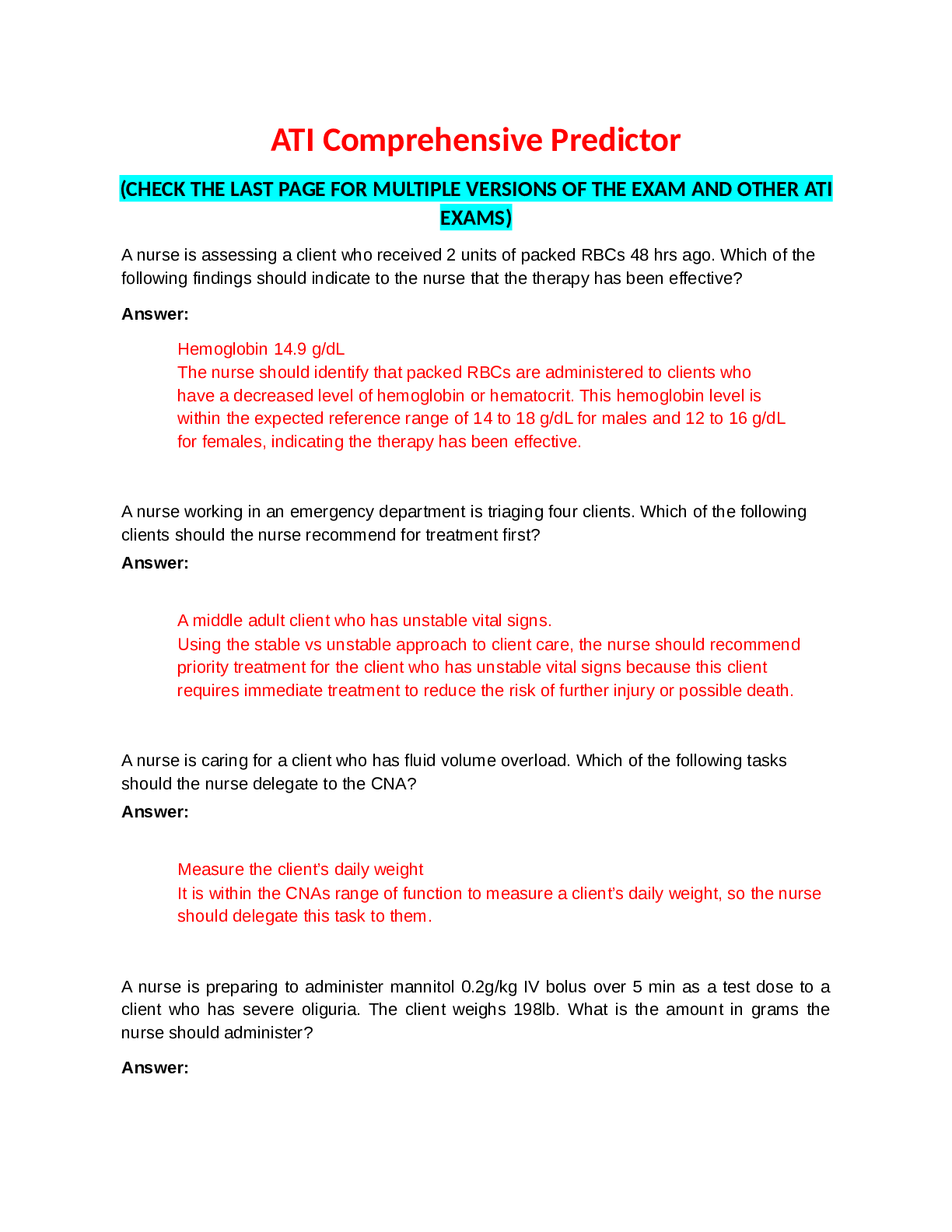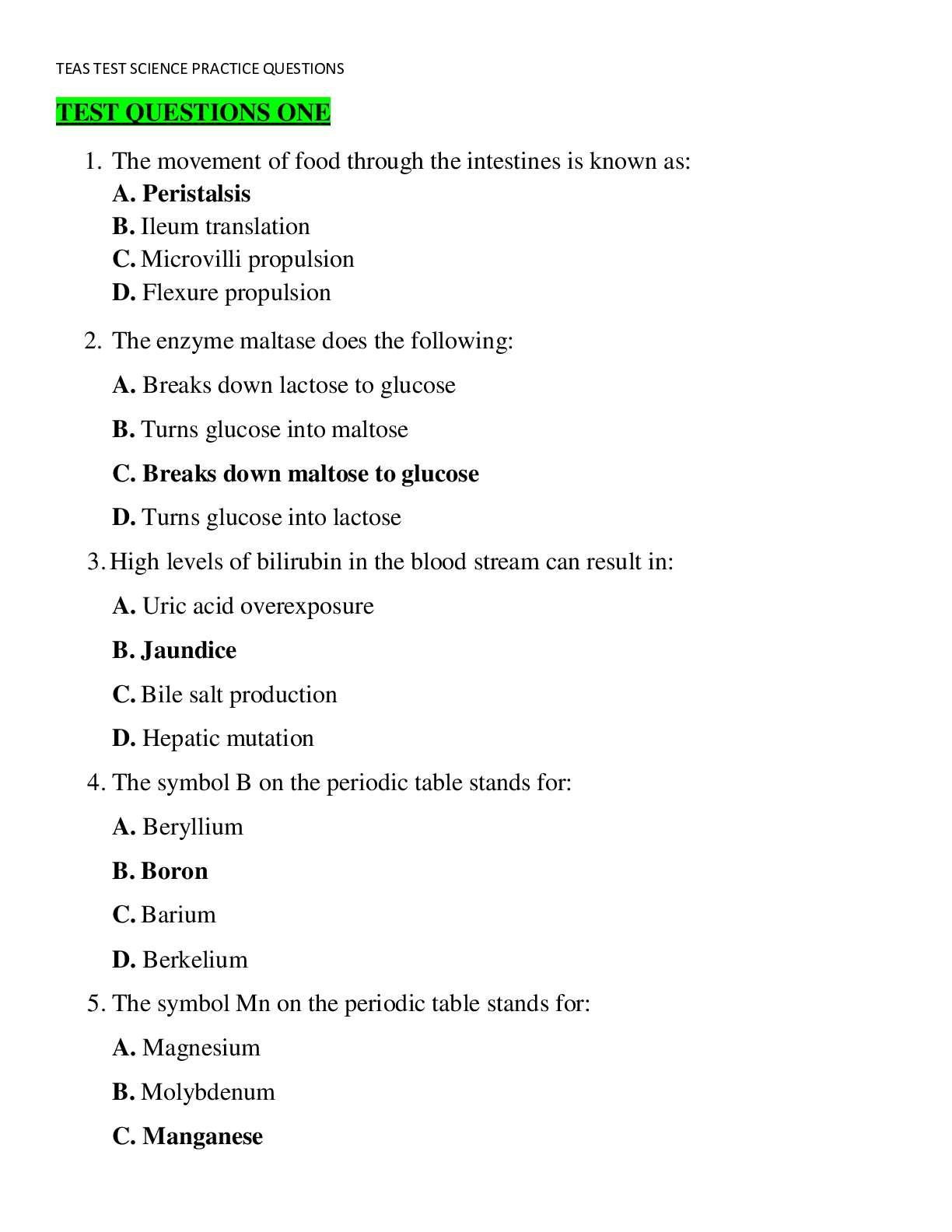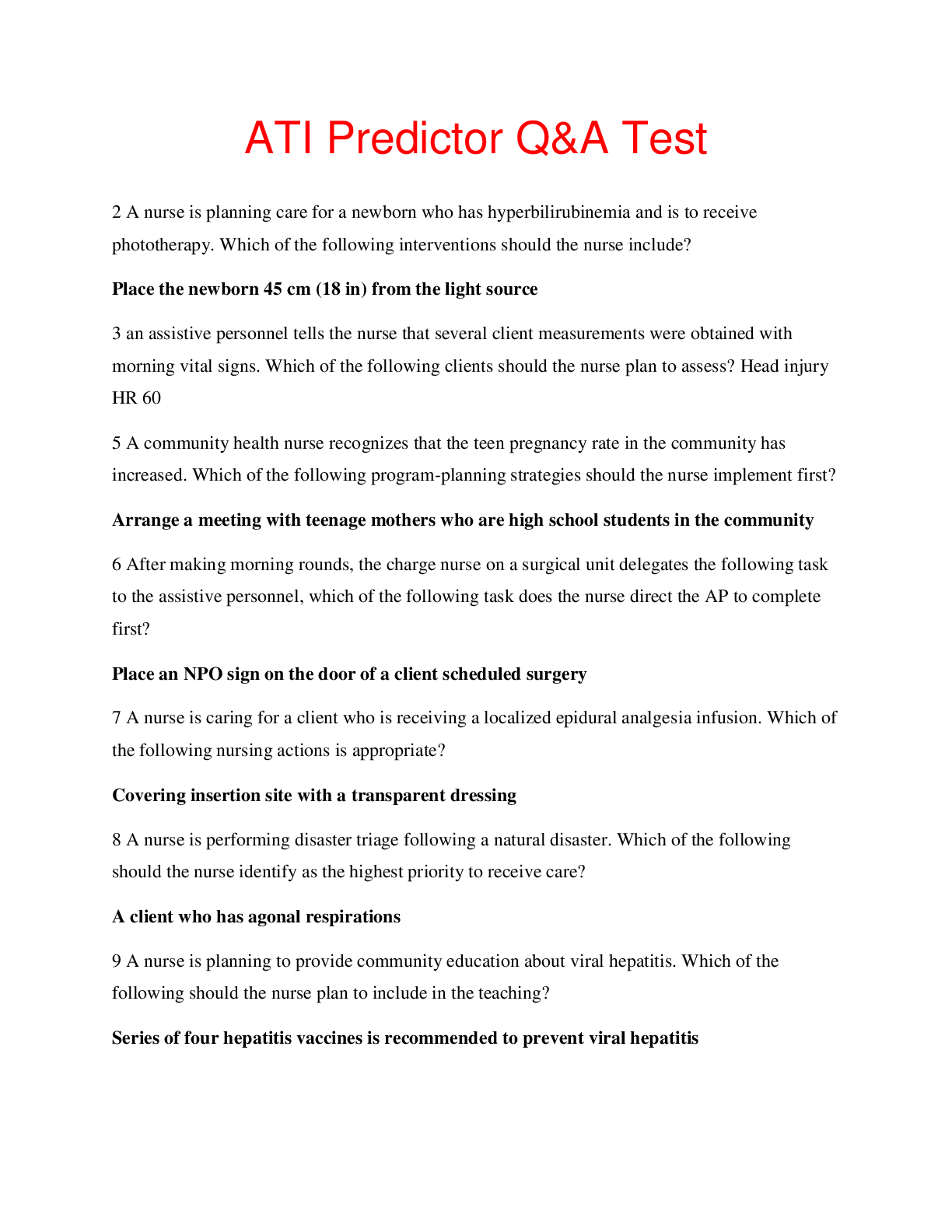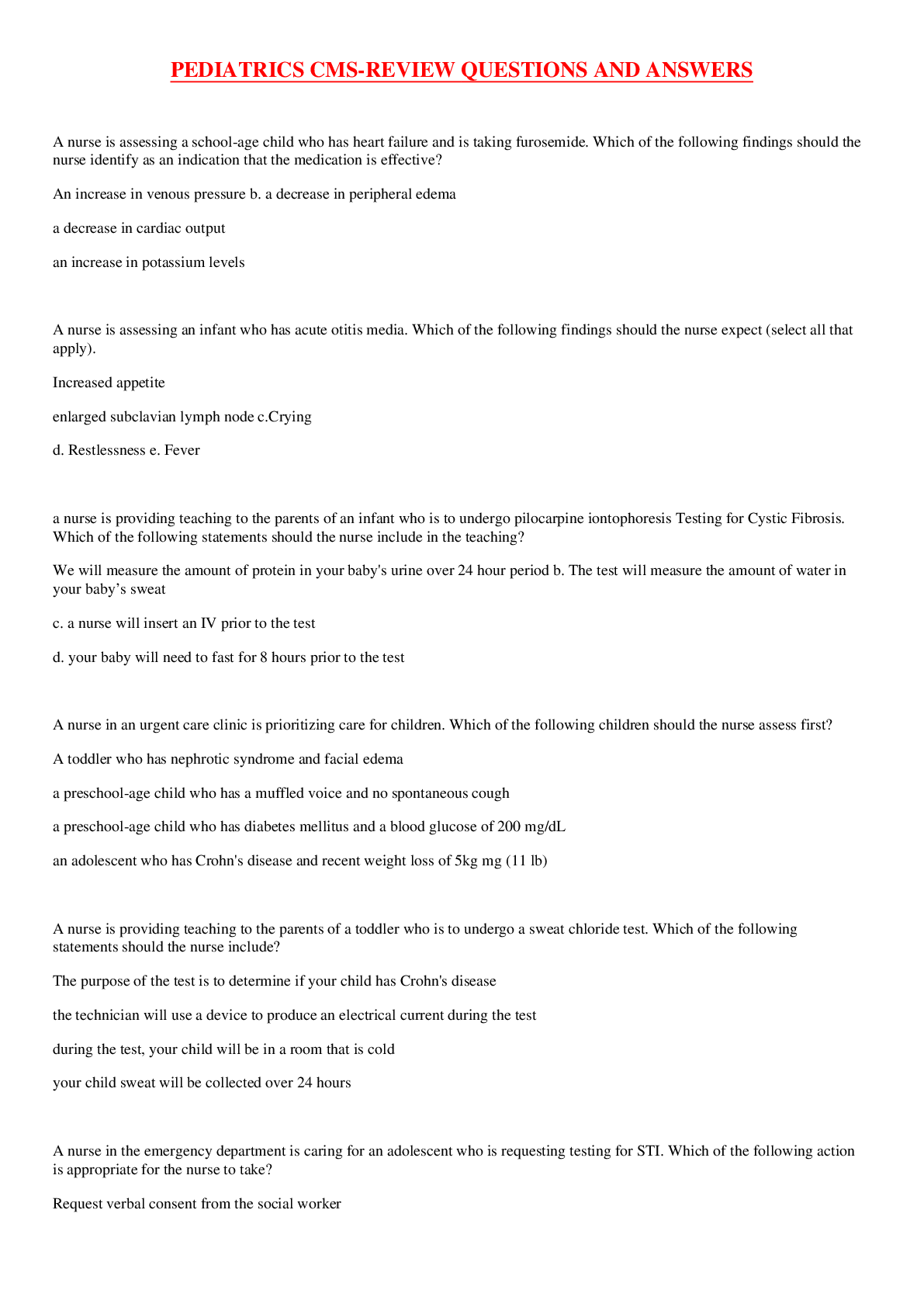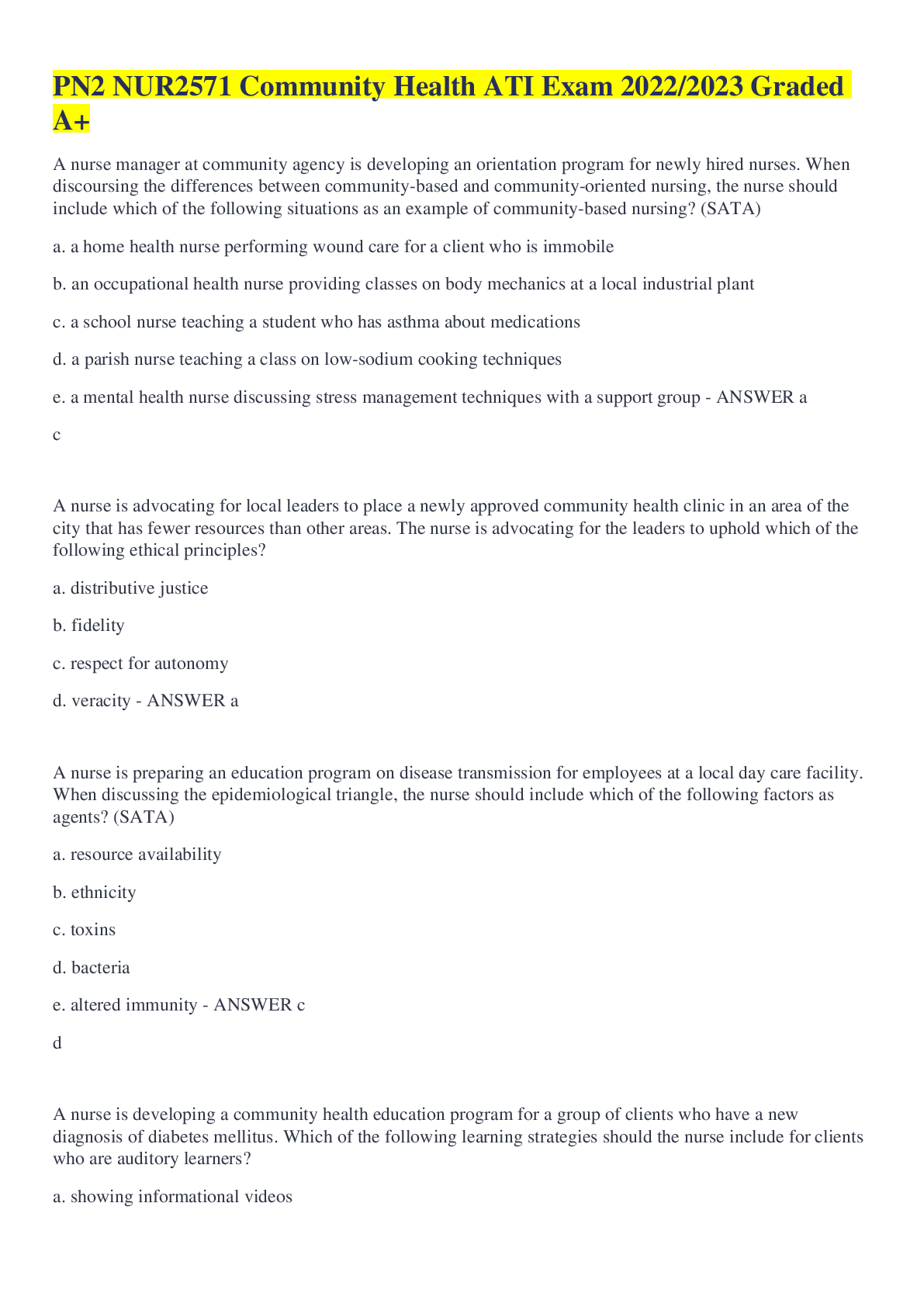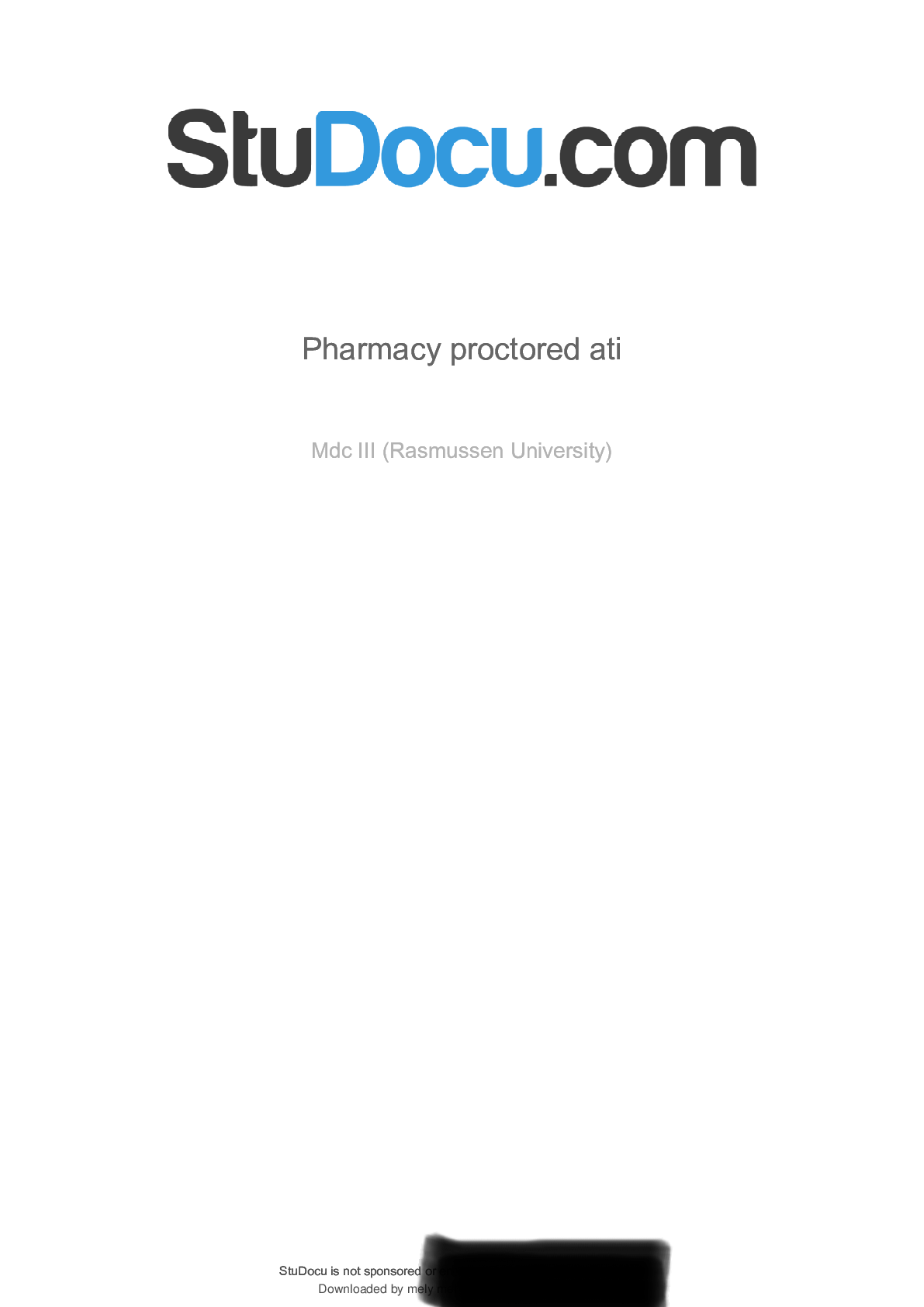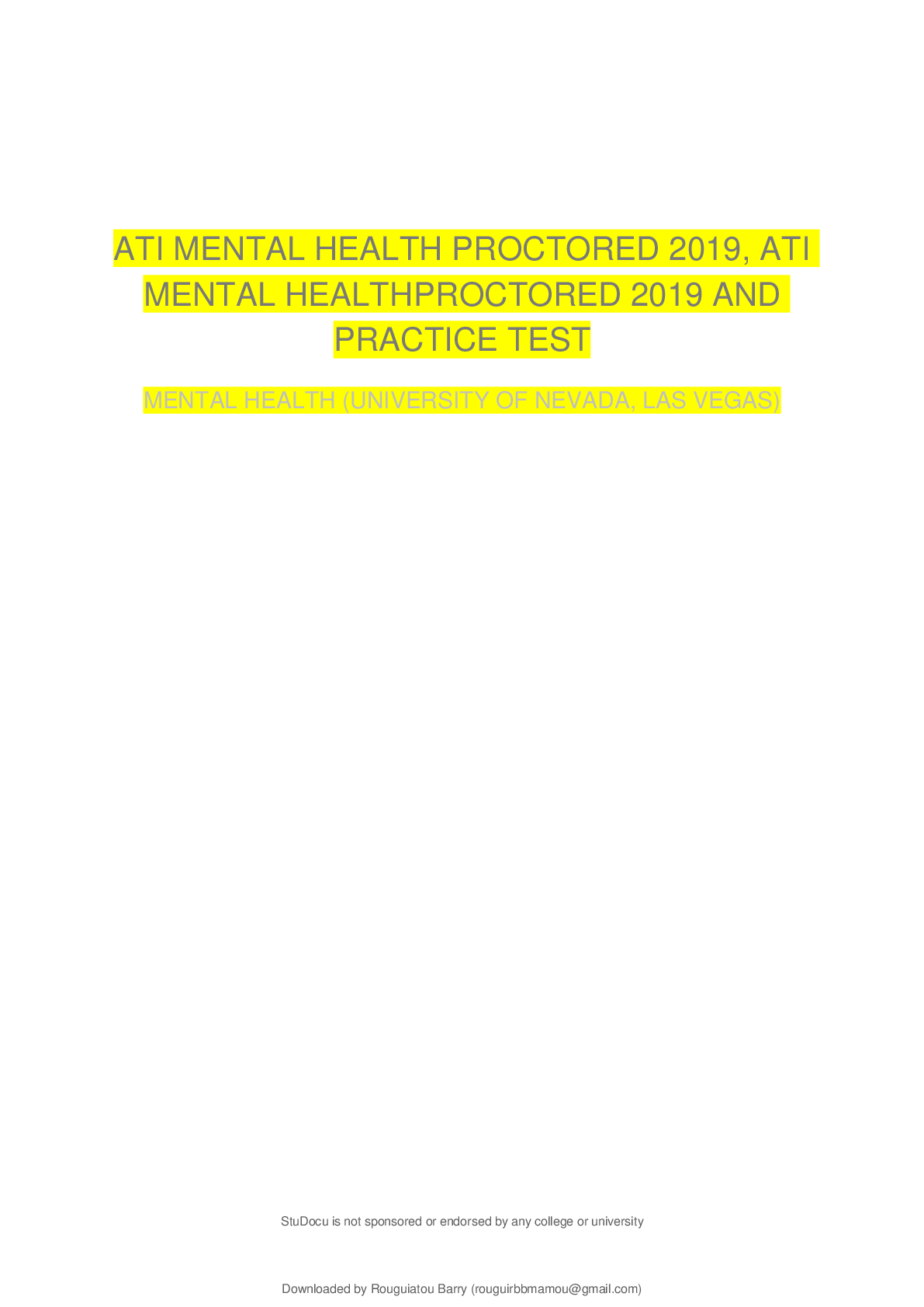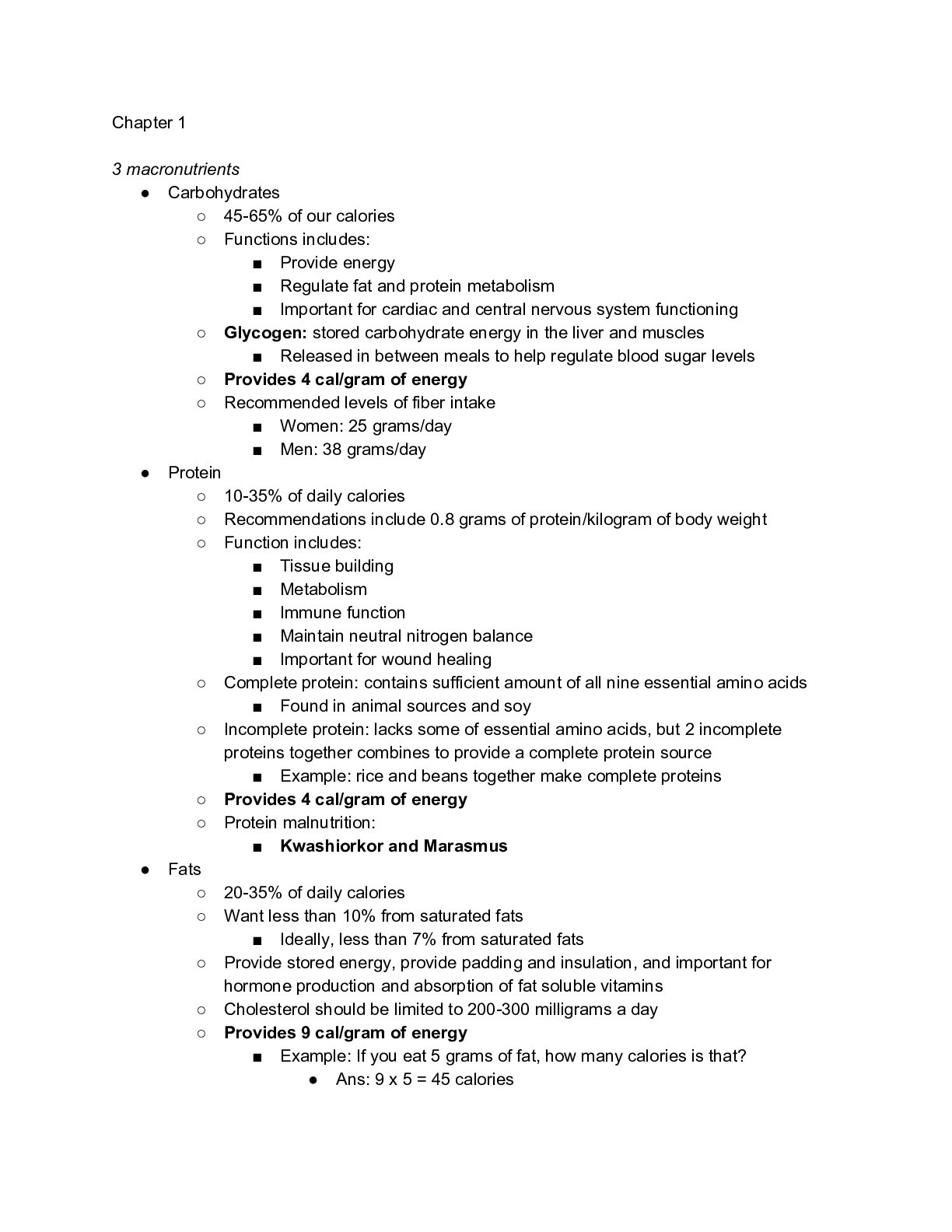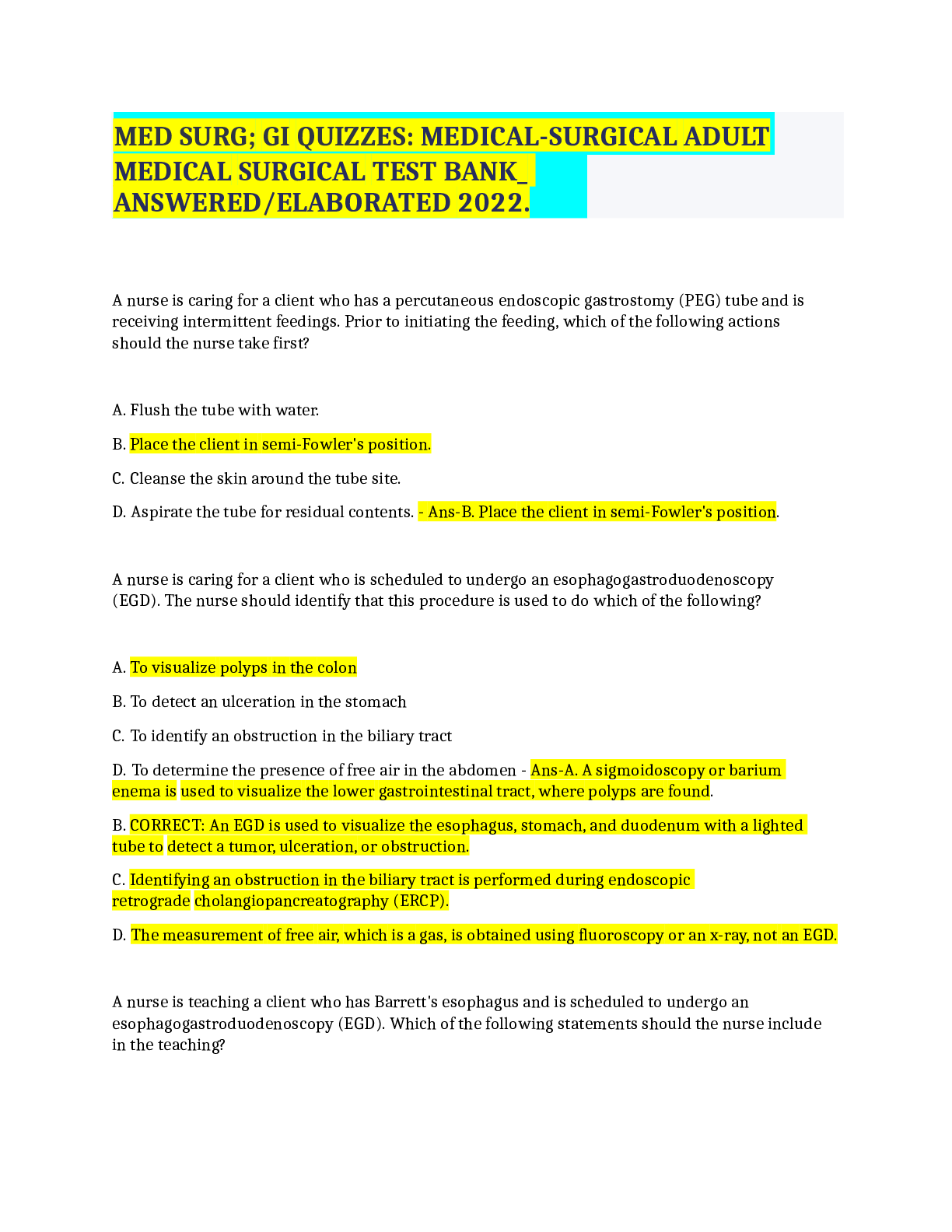NUR 6560 ATI EXAM 2 - QUESTIONS AND ANSWERS (LATEST VERSION)
Document Content and Description Below
NUR 6560 ATI EXAM 2 - QUESTIONS AND ANSWERS (LATEST VERSION) 1- A nurse is reviewing the laboratory results of a client who has metabolic alkalosis. Which of the following laborato ry values should th... e nurse expect? A. pH 7.31, HCO3- 22 mEq/L, PaCO2 50 mmHg B. pH 7.48, HCO3- 23 mEq/L, PaCO2 25 mmHg C. pH 7.32, HCO3- 18 mEq/L, PaCO2 40 mmHg D. pH 7.49, HCO3- 32 mEq/L, PaCO2 40 mmHg 2- A nurse in the emergency department is assessing a client who has deep, rapid respirations. Arterial blood gas analysis includes the following values: pH 7.25, PaCO2 40, and HCO3- 18. Which of the following acid-base imbalances should the nurse identify and report to the provider? A. Respiratory alkalosis B. Metabolic alkalosis C. Respiratory acidosis D. Metabolic acidosis 3- A nurse is caring for a client who is extremely anxious and is hyperventilating. The client's ABG results are pH 7.50, PaCO2 27 mmHg, and HCO3- 25 mEq/L. The nurse should identify that the client has which of the following acid-base imbalances? A. Respiratory acidosis B. Metabolic acidosis C. Respiratory alkalosis D. Metabolic alkalosis 4- A nurse is caring for an older adult client who has chronic obstructive pulmonary disease (COPD) with pneumonia. The nurse should monitor the client for which of the following acid-base imbalances? A. Respiratory alkalosis B. Respiratory acidosis C. Metabolic alkalosis D. Metabolic acidosis 5- A nurse is reviewing a client’s laboratory report. The client’s ABG levels are pH 7.5, PaCO2 32 mmHg, and HCO3- 24 mEq/L. The nurse should determine that the client has which of the following acid-base imbalances? A. Respiratory alkalosis B. Metabolic acidosis C. Respiratory acidosis D. Metabolic alkalosis 6- A nurse is rewarming a client following coronary artery bypass graft (CABG) surgery. For which of the following complications of the rewarming process should the nurse monitor the client? A. Acidosis B. Infection C. Hypertension D. Cardiac tamponade 7- A nurse is reviewing laboratory findings of an adolescent who has acute renal failure. Which of the following findings should the nurse expect? A. Hypokalemia B. Hypercalcemia C. Decreased plasma creatinine level D. Metabolic acidosis 8- A nurse is caring for a client who has emphysema and chronic respiratory acidosis. The nurse should monitor the client for which of the following electrolyte imbalances? A. Hyperkalemia B. Hyponatremia C. Hypercalcemia D. Hypomagnesemia 9- A nurse is assessing a client who is 12 hr postoperative following an open cholecystectomy. Which of the following findings should the nurse report to the provider? A. Hypoactive bowel sounds B. Indwelling urinary catheter output of 25 mL/hr (The nurse should report a urinary output of <30 mL/hr to the provider, as this can indicate hypovolemia or renal complication) C. Heart rate of 96/min D. Serous drainage at the surgical incision site 10- A nurse is reviewing the laboratory report of a client who has chronic kidney disease (CKD). The nurse finds the following laboratory test results: potassium 6.8 mEq/L, calcium 7.4 mg/dL, hemoglobin 10.2 g/dL, and phosphate 4.8 mg/dL. Which finding is the priority for the nurse to report to the provider? A. Hypocalcemia B. Hyperkalemia C. Anemia D. Hypoalbuminemia 11- A nurse is providing dietary teaching a client who has late-stage chronic kidney disease (CKD). Which of the following nutrients should the nurse instruct the client to increase in her diet? A. Calcium (CKD can develop hypocalcemia) B. Phosphorous C. Potassium D. Sodium 12- A nurse is checking the laboratory values of a client who has chronic kidney disease. The nurse should expect elevations in which of the following values? A. Potassium and magnesium (CKD pte have hyperkalemia, hyperphosphatemia, and hypermagnesemia) B. Calcium and bicarbonate C. Hemoglobin and hematocrit D. Arterial pH and PaCO2 13- A nurse is caring for a client who has chronic glomerulonephritis with oliguria. For which of the following electrolyte imbalances should the nurse monitor? A. Hypercalcemia B. Hyperkalemia (glomerulonephritis causes potassium retentation) C. Hypomagnesemia D. Hypophosphatemia 14- A nurse is caring for a client who has emphysema and chronic respiratory acidosis. The nurse should monitor the client for which of the following electrolyte imbalances? A. Hyperkalemia B. Hyponatremia C. Hypercalcemia D. Hypomagnesemia 15- A nurse is reviewing the laboratory findings of a client who has chronic kidney disease. The client reports significant persistent nausea and muscle weakness. Which of the following findings should the nurse expect? A. Hypernatremia B. Hypomagnesemia C. Hypercalcemia D. Hyperkalemia 16- A nurse is monitoring the electrocardiogram of a client who has hypocalcemia. Which of the following findings should the nurse expect? A. Flattened T waves B. Prolonged QT intervals C. Shortened QT intervals D. Widened QRS complexes 17- A nurse is caring for a client who has a major burn injury and is experiencing third spacing. Which of the following fluid or electrolyte imbalances should the nurse expect? A. Hypokalemia B. Hypernatremia C. Elevated Hct D. Decreased Hgb 18- A nurse is examining the ECG of a client who has hyperkalemia. Which of the following ECG changes should the nurse expect? A. Elevated ST segments B. Absent P waves C. Depressed ST segments D. Varying PP intervals 19- A nurse is reviewing the laboratory values of a client who has a positive Chvostek’s sign. Which of the following laboratory findings should the nurse expect? A. Decreased calcium B. Decreased potassium C. Increased potassium D. Increased calcium 20- A nurse is reviewing the laboratory data of a client who has a fever and watery diarrhea. Which of the following results should the nurse report to the provider? A. Calcium 9.5 mg/dL B. Sodium 150 mEq/L C. Potassium 4 mEq/L D. Magnesium 1.5 mEq/L 21- A nurse is reviewing the laboratory report of a 2-year-old child who has diarrhea and has been vomiting for 24 hr. Which of the following findings should the nurse report to the provider? A. Hct 40% B. Potassium 2.5 mEq/L C. Serum creatinine 0.4 mg/dL D. BUN 6 mg/Dl 22- A nurse is assessing a client who is receiving continuous ambulatory peritoneal dialysis. Which of the following findings should the nurse report to the provider? A. WBC 6,000/mm^3 B. Potassium 3.0 mEq/L C. Clear, pale yellow drainage D. Report of abdominal fullness 23- A nurse is monitoring a client's laboratory results. Which of the following results should the nurse report to the provider? A. Sodium 140 mEq/L B. Potassium 3.0 mEq/L C. Chloride 100 mEq/L D. Magnesium 2.0 mEq/L 24- A nurse is assessing a client who has heart failure and is taking daily furosemide. The client's apical pulse is weak and irregular. The nurse should identify these findings as manifestations of which of the following electrolyte imbalances? A. Hypokalemia B. Hypophosphatemia C. Hypercalcemia D. Hypermagnesemia 25- A nurse is assessing a client who has a total calcium level of 12.7 mg/dL. Which of the following findings should the nurse expect? A. Muscle tremors B. Positive Chvostek's sign C. Depressed deep-tendon reflexes (nausea, vomiting, bone pain, weakness, lethargy) D. Numbness around the mouth 26- A nurse is assessing for disseminated intravascular coagulation (DIC) in a client who has septic shock secondary to an untreated foot wound. Which of the following findings should the nurse expect? (Select all that apply.) Shock A. Bradycardia B. Bleeding at the venipuncture site C. Petechiae on the chest and arms D. Flushed, dry skin E. Abdominal distension 27- A nurse in the emergency department is caring for a client who has abdominal trauma. Which of the following assessment findings should the nurse identify as an indication of hypovolemic shock? Shock A. Warm, dry skin B. Increased urinary output C. Tachycardia D. Bradypnea 28- A nurse is caring for a client with dehydration who has developed hypovolemic shock. Which of the following laboratory values should the nurse expect for this client? A. BUN 18 mg/dL B. Capillary refill 1.5 sec C. Hct 55% D. Urine specific gravity 1.001 29- A nurse is caring for a client who is in hypovolemic shock. While waiting for a unit of blood, the nurse should administer which of the following IV solutions? Shock A. 0.45% sodium chloride B. Dextrose 5% in 0.9% sodium chloride C. Dextrose 10% in water D. 0.9% sodium chloride 30- A nurse is planning care for a client who is postoperative following a hip arthroplasty. In the client’s medical record, the nurse notes a history of chronic obstructive pulmonary disease (COPD). Which of the following oxygen-delivery methods should the nurse plan to use for this client? A. Simple face mask B. Nonrebreather mask C. Bag-valve-mask device D. Nasal cannula 31- A nurse is preparing a client who is scheduled to have an arthroscopy the following day. Which of the following statements indicates that the client understands the preprocedure teaching? A. "I have to keep my leg straight throughout the whole procedure." B. "The doctor will be able to see if I have signs of rheumatoid arthritis." C. "I should expect to stay overnight until I can walk around." D. "I'll have a scar that will be about an inch long 32- A nurse is providing postoperative discharge teaching to a client following a panhysterectomy for uterine cancer. Which of the following pieces of information should the nurse include in the teaching? A. "You will need to continue to use some form of birth control for 6 months." B. "You might experience manifestations of menopause." C. "Do not lift anything heavier than 15 lb." D. "Pain or burning with urination is an expected outcome of this surgery." 33- A nurse is providing discharge teaching for a client who had a left total hip arthroplasty. Which of the following client statements indicates the teaching was effective? A. "I should expect swelling of the affected leg for several weeks." B. "I should not cross my legs at the ankles or knees." C. "I will inspect my hip incision every other day for redness." D. "I can bend over at the hip to pick up objects." 34- A nurse is caring for a client who is postoperative following a parathyroidectomy to treat hyperparathyroidism. Which of the following laboratory values should the nurse expect to decrease as a therapeutic effect of the procedure? A. Calcium B. Sodium C. Potassium D. Phosphorous 35- A nurse is preparing a client who is postoperative following total hip arthroplasty for discharge. Which of the following statements indicates that the client understands the instructions? A. "I'll use alcohol pads to clean my incision each day." B. "When I'm doing my exercises, I'll include bent-leg raises." C. "I'll use a reacher to help me pick up anything I drop on the floor." D. "When I can walk without my walker, I can stop attending physical therapy." 36- A nurse is caring for a client who is postoperative following a total knee arthroplasty and has been prescribed a continuous passive motion (CPM) machine and PCA. The client tells the nurse, "I am in so much pain." Which of the following actions should the nurse take first? A. Remind the client to push the button for the PCA device B. Discuss activities the client may use to distract from the pain C. Ask the client to describe the characteristics of the pain D. Pause the CPM machine briefly to apply a cold pack to the client’s knee 37- A nurse is caring for a client who is 3 days postoperative following abdominal surgery. The client states, "Something just popped when I coughed." Which of the following actions should the nurse take first? A. Cover the client's wound with a sterile, moist dressing B. Flex the client's knees C. Reassure the client D. Instruct the client to avoid coughing 38- A nurse is caring for a client who is postoperative following shoulder surgery. The client has a prescription to keep the affected arm adducted. Which of the following instructions should the nurse share with the client? A. "Keep your arm bent at the elbow." B. "Use a pillow to prop your shoulder up close to your ear." C. "Hold your arm against the side of your body." D. "Position your arm with the shoulder at a 90° angle." 39- A nurse is caring for a client who had a gastric resection to treat adenocarcinoma of the stomach. The client tells the nurse in the PACU that he does not remember why the surgeon said he had to have a tube in his nose. The nurse should explain that the NG tube serves which of the following purposes? A. Prevents excessive pressure on suture lines B. Allows gastric lavage after surgery C. Allows early postoperative feeding D. Facilitates obtaining gastric specimens for testing 40- A nurse is preparing a client for discharge who is postoperative following a conventional lumbar disk excision. Which of the following statements indicates that the client understands the nurse’s instructions? A. "I should have no problem climbing stairs when I get home." B. "I'll wait about 3 weeks before I return to my usual activities." C. "I'll use my heating pad if I feel any muscle spasms in my back." D. "I can go back to driving in about 2 weeks or so." 41- A nurse is providing discharge instructions for a client who is postoperative following inner maxillary fixation with wiring. Which of the following pieces of information should the nurse include? A. Cut the wiring if emesis occurs B. Consume 3 meals daily as part of a low-protein diet C. Swab the mouth with hydrogen peroxide if wiring produces oral irritation D. Resume a soft diet in 3 to 5 days 42. A nurse is assessing a client who is 48 hr postoperative following open reduction and internal fixation of a fractured tibia. Which the following findings should the nurse report to the provider? A. Toes that are cold to the touch B. Serous drainage from the pin sites C. Blanching of the toenail beds with pressure D. Pink tissue around the fixator insertion sites 43. A nurse is caring for a client who is postoperative following vein ligation and stripping for varicose veins. Which of the following actions should the nurse take? A. Position the client supine with his legs elevated when in bed B. Encourage the client to ambulate for 15 min every hour while awake for the first 24 hr C. Tell the client to sit with his legs dependent after ambulating D. Instruct the client to wear knee-length socks for 2 weeks after surgery 44. A nurse is caring for a client who is postoperative following a frontal craniotomy. The nurse should place the client in which of the following positions? Perioperative A. Trendelenburg B. Prone C. Semi-Fowler's D. Sims' 45- A nurse is assessing a client who is 4 hr postoperative following a transurethral resection of the prostate and has an indwelling urinary catheter in place. Which of the following findings should the nurse expect? A. Blood-tinged urine in the drainage bag B. Catheter tubing coiled at the client's side C. Client report of severe bladder spams D. Urinary output of 20 mL/hr 46- A nurse is planning care for a client who is postoperative following a radical mastectomy. Which of the following interventions should the nurse include in the plan? Perioperative A. Rest the arm on the affected side on the bed when the client is sleeping B. Instruct the client to keep the affected arm flexed when ambulating C. Begin exercises with the client 1 day after the procedure D. Maintain the client on bed rest for 2 days after the procedure 47. A nurse is teaching a client who is preoperative for a cystoscopy. Which of the following statements should the nurse make? A. "You will need to keep the sutures clean after this procedure." B. "You will be placed on your left side for this procedure." C. "Expect to be on bed rest for 24 hr after this procedure." D. "Expect to have pink-tinged urine after this procedure." 48- A nurse is providing teaching to a client who is preoperative prior to a transurethral resection of the prostate (TURP). Which of the following client statements indicates an understanding of the information? A. "I will not need to have a urinary catheter following this procedure.” B. "I will expect my urine to be cloudy after having this procedure." C. "At least I won’t have leakage of urine after having this procedure." D. "I will feel the urge to urinate following this procedure." 49- A nurse is providing preoperative teaching for a client who is scheduled for total knee arthroplasty. Which of the following statements by the client indicates an understanding of the teaching? [Show More]
Last updated: 1 year ago
Preview 1 out of 28 pages
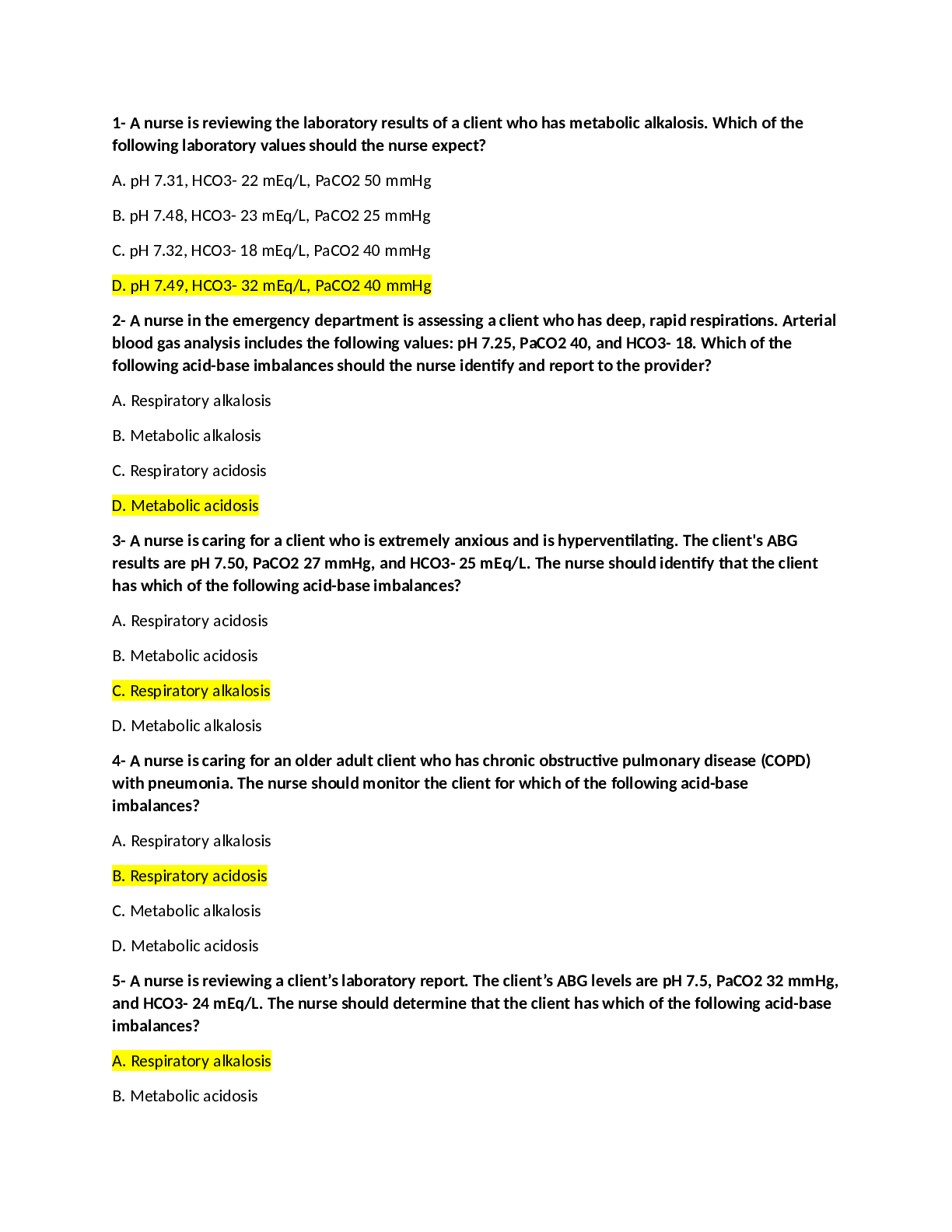
Reviews( 0 )
Document information
Connected school, study & course
About the document
Uploaded On
Jan 11, 2022
Number of pages
28
Written in
Additional information
This document has been written for:
Uploaded
Jan 11, 2022
Downloads
0
Views
41


